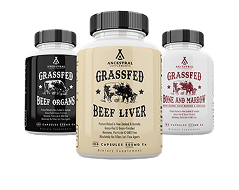Regenerative Farming: What It Is & Why It Matters

Regenerative farming marks a pivotal shift in modern agriculture, embodying a commitment to sustainability and offering hope for a brighter future. Join us as we explore its principles and profound impact on the planet.
By diving into regenerative farming, we're not just growing crops; we're growing hope for a greener, more vibrant planet where every organism thrives—from the tiniest microbe in the soil to the cows grazing above it.
What Is Regenerative Farming?
Regenerative agriculture represents a paradigm shift within our approach to the food system and production. It’s a comprehensive farming system that focuses on regenerating natural resources, building long-term resilience, and reducing greenhouse gas emissions, with a much deeper emphasis on soil health.
In contrast to industrial agriculture, which often promotes soil erosion, nutrient runoff, chemical saturation and monocropping, regenerative farming seeks to rehabilitate, rejuvenate and conserve the ecosystem while simultaneously providing agricultural yields.
It's literally a win-win-win of a situation! And most importantly, this approach provides a unique answer to the pressing question: How can we increase food production without causing further environmental degradation?
Another fun fact is that regenerative agriculture operates without strict guidelines, instead relying upon holistic principles, tailored to local conditions and designed to align with nature’s cycles and ecosystem services. This flexibility allows for a diversity of regenerative farming methods, each adapted to their specific region and circumstances.
What Are Common Regenerative Farming Practices?
Common regenerative farming practices include no-till farming, cover cropping, composting, and rotational grazing. These techniques foster soil health, biodiversity, and ecosystem resilience, contributing to a more sustainable agricultural system.
No-Till Farming
One of the most common practices in regenerative farming is no-till farming. Tilling, also known as plowing or cultivation, is the process of breaking up and turning over soil using a tool such as a plow, hoe, or rototiller. It's typically done to prepare soil for planting crops, improve soil structure, and control weeds.
By leaving the soil undisturbed, farmers can actually improve soil health and reduce erosion, all while cutting back on labor and fuel costs.
Cover Cropping
Cover cropping is another crucial practice... Cover cropping involves planting specific crops, known as cover crops, during the off-season or alongside main crops. These cover crops help improve soil health by preventing erosion, suppressing weeds, adding organic matter, and fixing nitrogen. It also helps to enhance soil fertility, and control pests and diseases.
Composting
Composting is the process of turning organic waste, like food scraps and yard trimmings, into nutrient-rich soil. It involves piling up these materials and letting them decompose naturally with the help of microorganisms like bacteria and fungi.
By turning organic waste into nutrient-rich compost, farmers can feed the soil and promote healthy soil, contributing to a productive ecosystem and rebuilding soil organic matter, reduce waste, and help to sequester carbon in the soil, contributing to the fight against climate change.
Rotational Grazing
Rotational grazing is a regenerative practice that involves moving livestock regularly to fresh pastures to prevent overgrazing and allowing the grass to recover, which promotes deeper root systems and healthier soil structure.
This process balances the needs of the animals with the capacity of the land, which means carefully managing the timing and intensity of grazing to match the growth cycles of the pasture plants. In turn, this promotes healthier animals and more resilient pastures, as the livestock benefit from a diet of diverse forage, and the land benefits from natural fertilization through animal waste.
The Benefits of Regenerative Agriculture
The benefits of regenerative farming extend far beyond the farm gate. They ripple outwards, contributing to healthier ecosystems, stronger communities, and a more sustainable economy. Let’s dive into these benefits a little deeper…
Environmental Benefits
Regenerative farming can dramatically reduce the impact on the ecosystem and actually has the potential to restore natural balances when the true cost of food is considered. Practices like composting and cover cropping help to rebuild soil organic matter, sequester carbon, and incorporate restoring degraded soil biodiversity. This, in turn, improves water regulation, reduces soil erosion, and enhances resilience to climate shocks. Moreover, these practices contribute to reduce greenhouse gas emissions, further promoting a sustainable environment. (1)
Social Benefits
These farming practices foster community connections and contribute to healthier societies. They provide healthier, more nutrient-dense food, contributing to improved public health. Furthermore, they create more resilient food supply chains, helping to ensure food security in the face of increasing climate uncertainty.
Benefits for Livestock
Regenerative farming offers a buffet of benefits for our livestock. By integrating rotational grazing, cows munch on diverse grasses, which improves their nutrition and overall health. This practice mimics natural grazing patterns, promoting stronger, more resilient grasslands. Healthier pastures mean happier cows, and happier cows often lead to higher-quality milk and beef. Additionally, as these cows graze, they naturally fertilize the soil with their manure, enhancing soil fertility and structure, which is yet another win for the farm and the environment.
Economic Benefits
By enhancing soil health and reducing reliance on external inputs like fertilizers and pesticides, these practices not only lower expenses but also enhance profitability for farmers, while also minimizing environmental pollution, preserving biodiversity, and promoting long-term sustainability. Moreover, by capturing carbon and preserving ecosystems, regenerative agriculture can deliver valuable ecosystem services, contributing to a more sustainable and resilient economy.
How Regenerative Farming Traces Back to Our Ancestors
Regenerative farming is not a new concept. In fact, it’s as old as agriculture itself. Long before the advent of chemical fertilizers and mechanized farming, our ancestors practiced a form of regenerative agriculture. They understood the importance of maintaining a harmonious relationship with nature, of preserving the soil and conserving water resources.
By returning to these ancestral practices, we’re not just going back to our roots—we’re moving forward. We’re learning from the wisdom of our ancestors and applying it to the challenges of today. Regenerative farming represents a fusion of tradition and innovation, of ancient wisdom and cutting-edge science. It’s about taking the best of the past and the present to build a more sustainable and resilient future through regenerative practices.
Our Commitment to Regenerative Farming
As advocates of regenerative farming, we love to walk the walk and talk the talk! We want you to know that our commitment to this method of farming isn’t just theoretical—it’s practical and tangible. We source our products from multi-generational regenerative farms in New Zealand and Australia, ensuring that every purchase supports this transformative approach to agriculture.
But our commitment goes beyond sourcing. We’re dedicated to promoting regenerative farming practices and raising awareness about their benefits. We believe that by supporting regenerative farming, we’re not just investing in our business, we’re investing in the future of our planet.
We’re proud to be part of the regenerative agriculture movement. We’re proud to support farmers who care about the soil, the environment, and the health of their communities. And we’re proud to offer products that reflect these values.
Conclusion
Regenerative farming is so much more than just a set of agricultural practices… It’s a philosophy, a way of life. It’s about nurturing the soil, caring for the environment, and building resilient, sustainable food systems. It’s about taking responsibility for our planet and working towards a healthier, more sustainable future.
We’re beyond proud to be part of this movement, and we invite you to join us! Whether you’re a farmer, a consumer, or simply a concerned citizen, there’s a place for you in the regenerative agriculture revolution. Together, we can transform our food system, protect our planet, and build a brighter future for all.



















